1. Strictly select pesticides and strictly implement pesticide safety intervals
The pesticides used in the production of five public cherries should be strictly screened, and biological pesticides should be used preferentially, and high-efficiency, low-toxic and low-residue chemical pesticides should be selectively used. These pesticides mainly include: insecticides: Bt series, avermectin series, pyrethrins, plant extracts (such as bitter lactone, capsaicin, etc.), insect hormones (Miman, Kadike, Yitaibao) ), a small number of organophosphorus pesticides (trichlorfon, lesben, agricultural music) and other pesticides such as imidacloprid; fungicides: Bordeaux mixture, polyoxygen, methyl thiophanate, Shigao, Fuxing, can kill, Chlorothalonil, Teflon, Bacod, pyrimethanil, etc.; herbicide: grass, grass, etc.; aerosol: sulfur fumigant, keering, smog and so on.
In the whole process of strawberry production, it is strictly forbidden to use methamidophos, carbofuran, insecticidal mites, omethoate, dicofol, methyl 1605, sodium pentachlorophenol, ketone, chloropicrin, and herbicide ether. Residual pesticides.
The pesticide residue of strawberry fresh fruit is closely related to the length of the last application time. When the interval is short, the amount of pesticide residues is large, and vice versa. Therefore, producers must strictly control the safety intervals of various pesticides. Generally, the strawberries are harvested before or after the harvesting of the strawberries for about 10 days, and the pesticides with long residual period, such as imidacloprid, should be harvested and marketed more than 15 days after the administration.
Second, pay attention to prevention and control strategies and accuracy
Grasping the control period Any pests and diseases have certain regularity in the field. According to the law of growth and decline of pests and diseases, pay attention to prevention and control strategies, accurately grasp the appropriate period of prevention and control, and accurately select suitable pesticides, which has twice the result with half the effort. The control of noctuidae moths such as Spodoptera litura should master the principle of “one cure and two pressuresâ€, that is, the prevention and control of the second generation of pest bases, and should be controlled during the evening, because it is hidden in the ground during the day, and the application has almost no effect. When the pesticide is applied in the evening, it will be effective. The prevention and control of red spiders should be mastered in the stage of spotting. Strawberry virus disease is closely related to aphids. As long as the aphids are well controlled, the incidence of viral diseases can be significantly reduced. At the same time, according to the occurrence of pests and diseases in the field, it is very important to accurately select the method of application. If it can be ruled out, it can never be treated universally. The production of pollution-free strawberries should be minimized, and the least amount of medicine should be applied to achieve the best control effect.
Third, the right amount, alternating and scientific medication
Moderate medication is an important means of scientific medication. There are some misunderstandings in some producers, and the more the drug is used, the better the insecticidal or curative effect. Some farmers use 1-2 times the prescribed amount, which not only increases the cost, but also causes phytotoxicity, while the control effect is not improved and will have a great negative effect. Therefore, what kind of pests and diseases, what medicine to use, and how many doses should be used should be strictly controlled.
Pesticides must be used interchangeably to enhance the efficacy of the pesticide and delay the development of resistance to pests. Some raspberry farmers like to use a pesticide repeatedly when using it, which will gradually form resistance to the pest and disease, and the chemical control effect will gradually decline. One of the effective methods for overcoming and delaying drug resistance is to alternately use two or more pesticides with different mechanisms of action, and to pay attention to the selection of agents that do not have cross-resistance. If a pesticide has developed resistance, it can be discontinued for several years before being activated. If you need to use mixed pesticides, you should use them now. Before mixing, you should check the “mixed use check tableâ€. For example, mancozeb can be mixed with trichlorfon and dichlorvos, but not with Bordeaux mixture or stone sulfur. Mixtures and the like are mixed.
Gas Cylinder is a kind of special pressure vessel. All cylinder we sell are seamless steel cylinder, classify from filling medium, it can be divided into two types: dissolved Acetylene Cylinder and liquefied propane cylinder.
Dissolved acetylene cylinder is a cylinder special for filling acetylene. Because acetylene gas is very unstable, it must be dissolved in solvents (usually acetone). The cylinder is filled with porous material to absorb the solvent. Acetylene bottle filling acetylene gas, general requirements of two times, after the first inflated, static 8h above, and then second times inflated.
Packaging: Standard export package or Customized
Payment: L/C,D/P,T/T,Western Union
Delivery: NINGBO CHINA, 30 days after payment

Gas Cylinder
Gas Cylinder,Oxygen Cylinder,Acetylene Cylinder,Gas Tank
UWELD TECHNOLOGIES CO., LTD. , http://www.uweldco.com